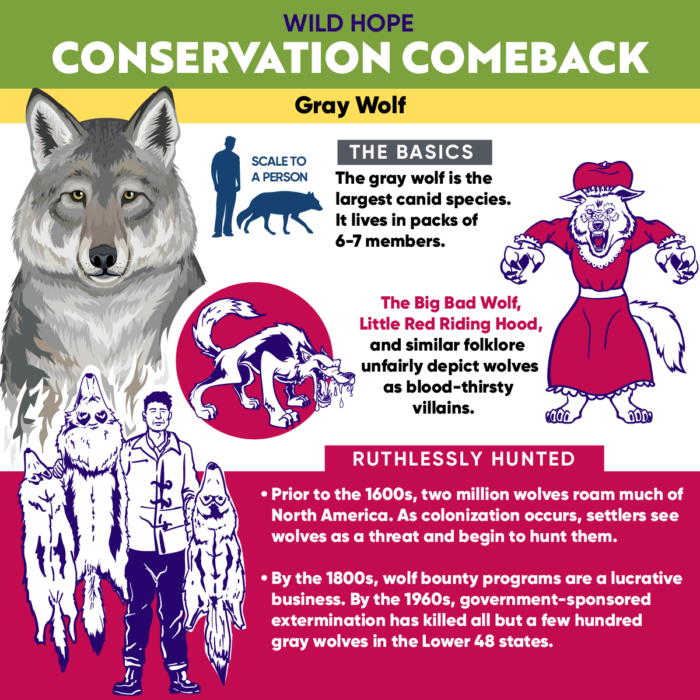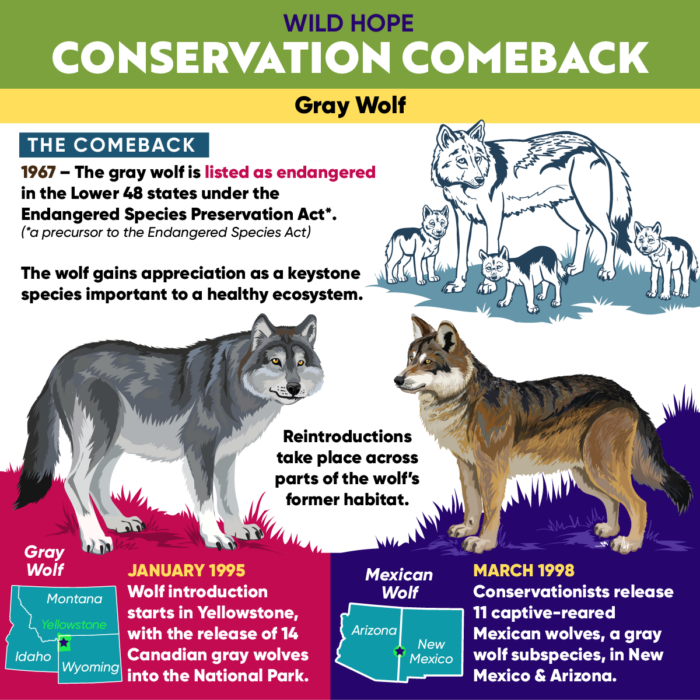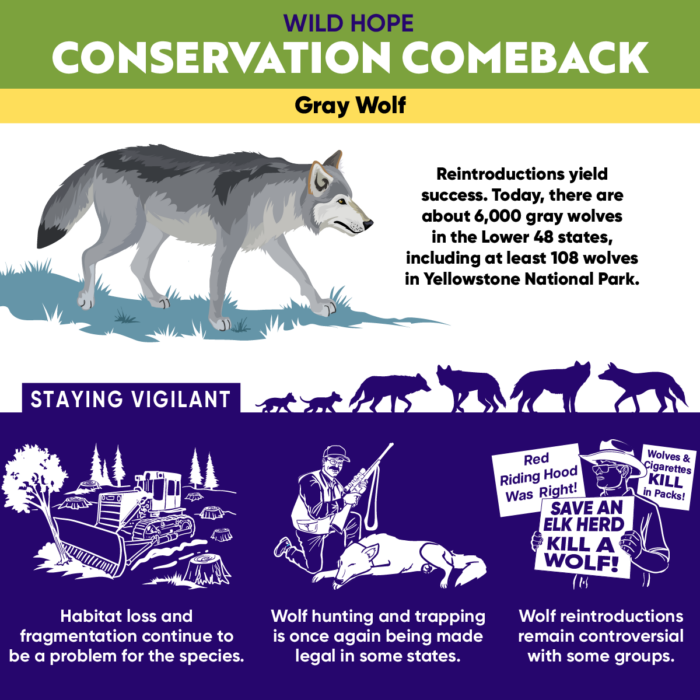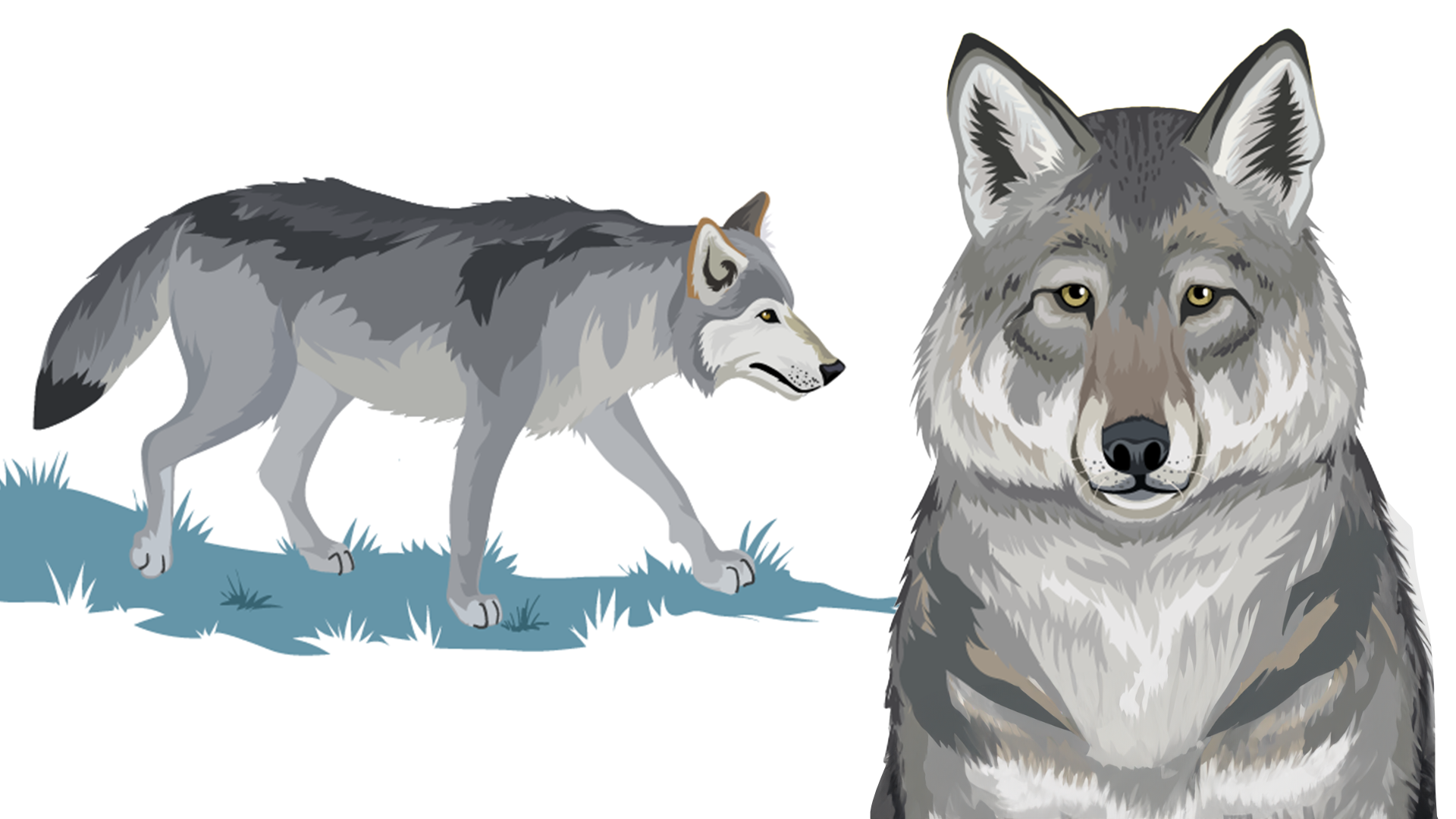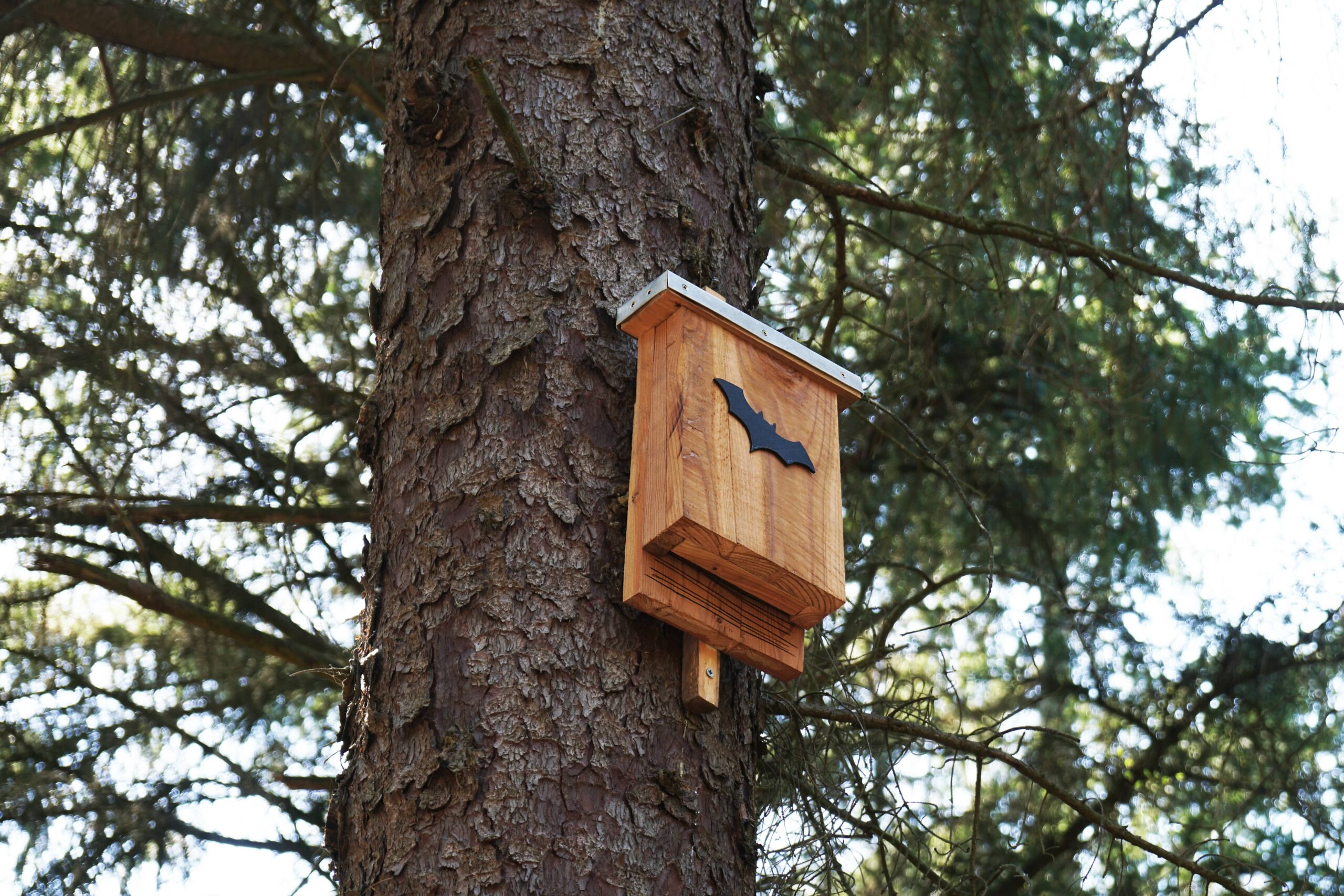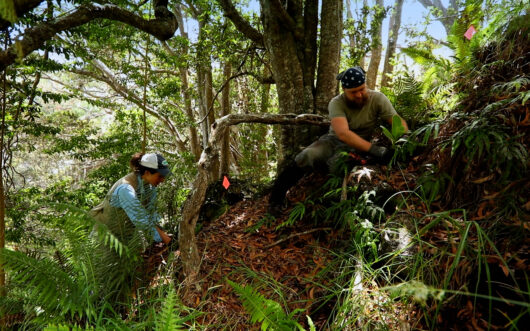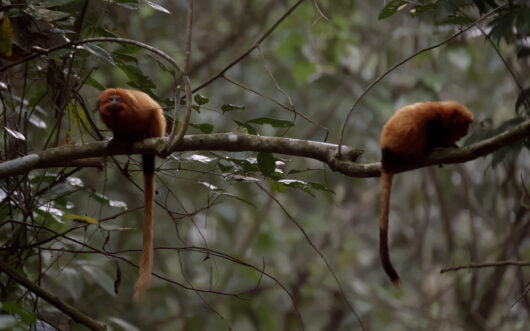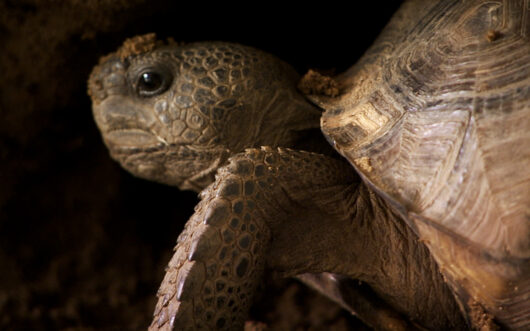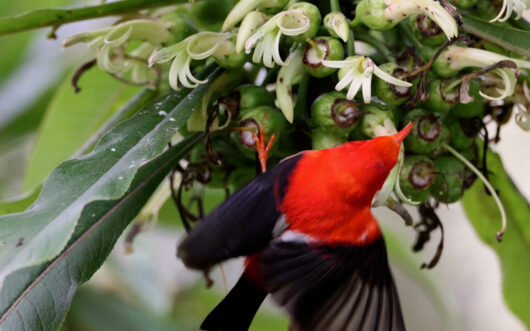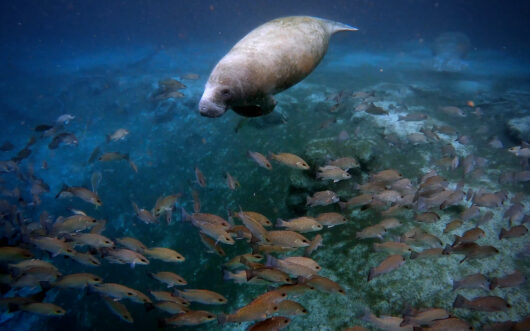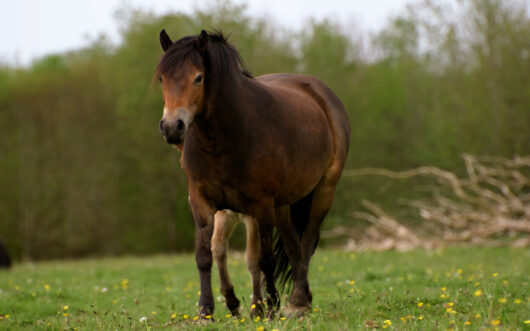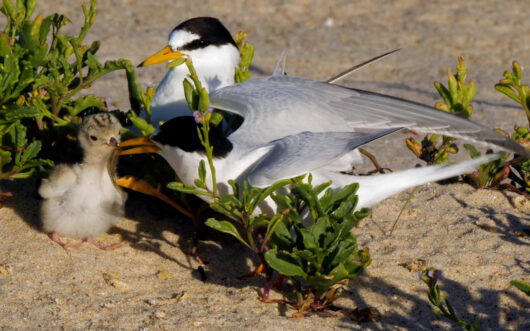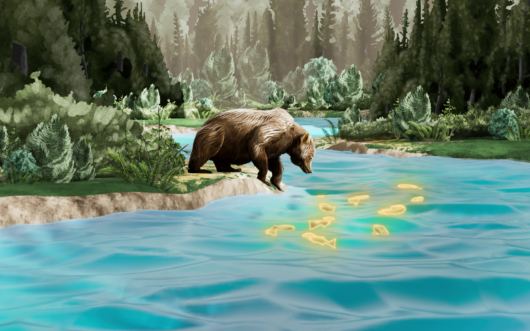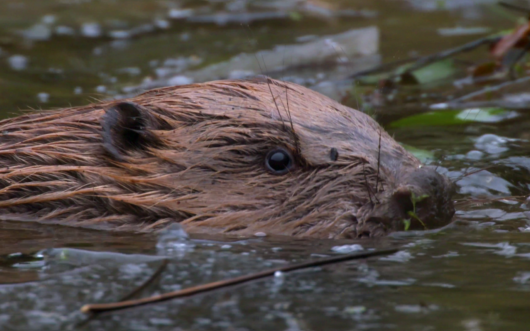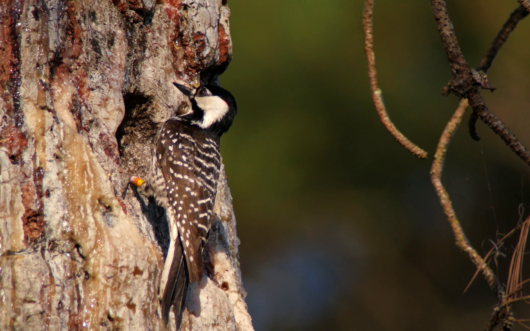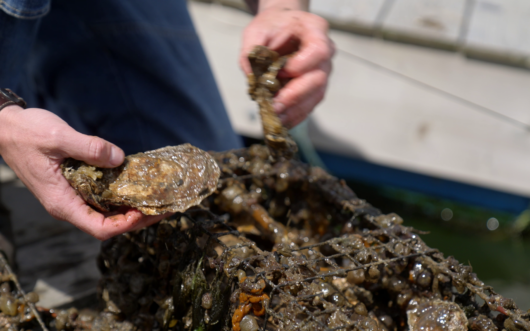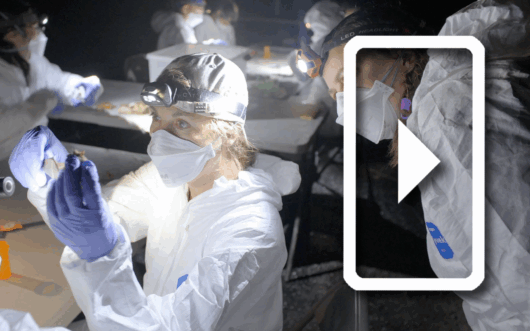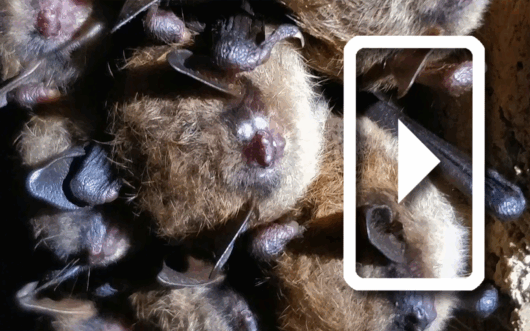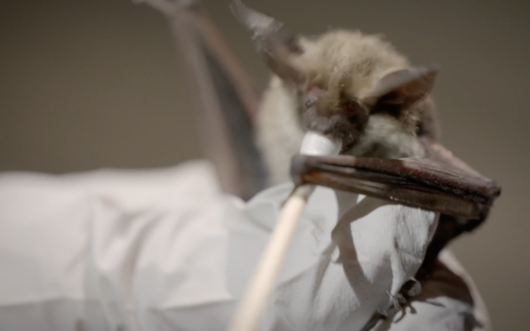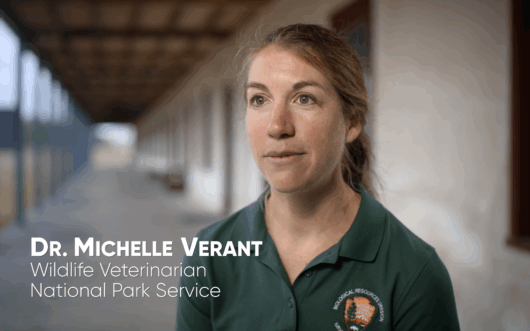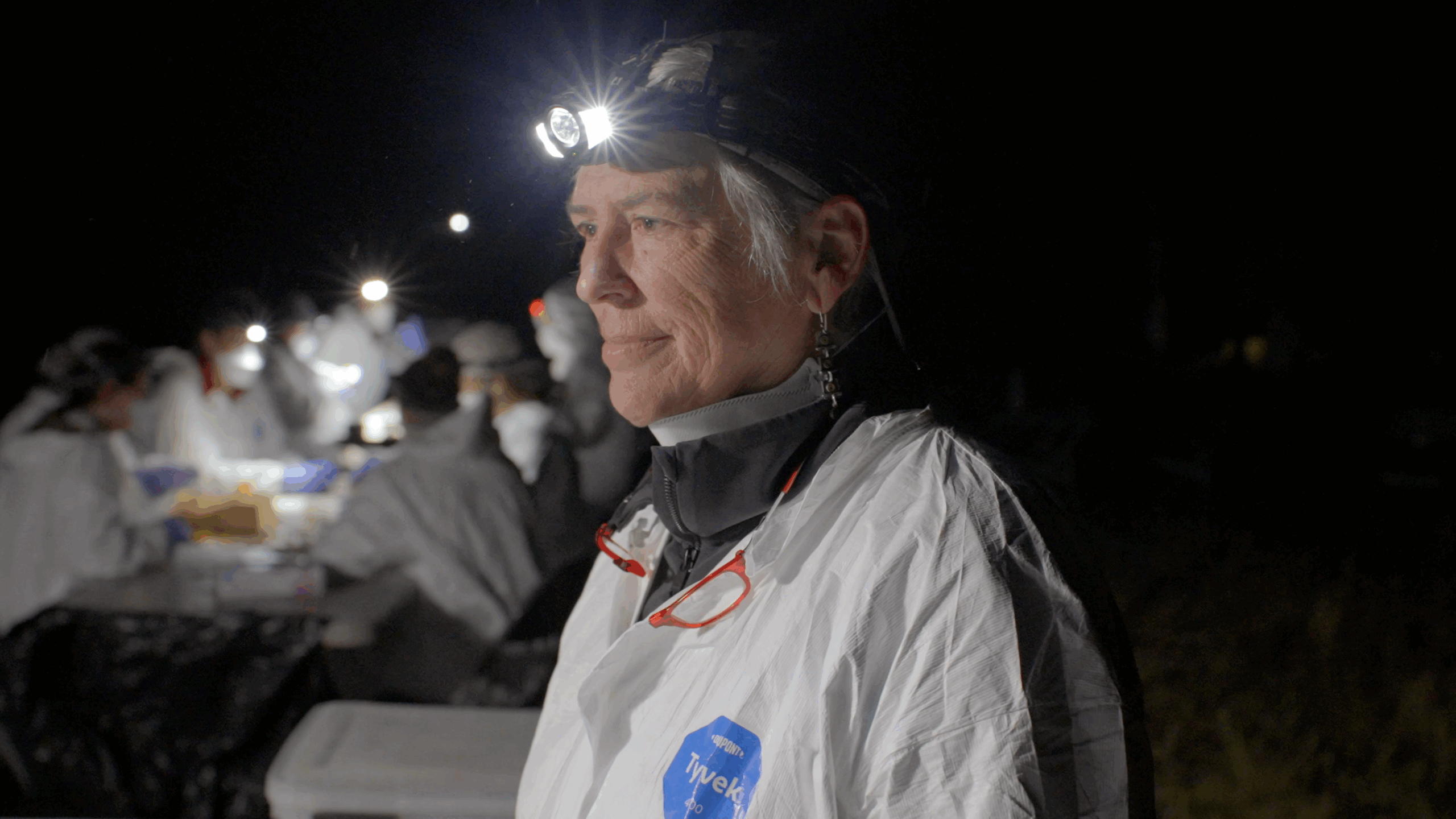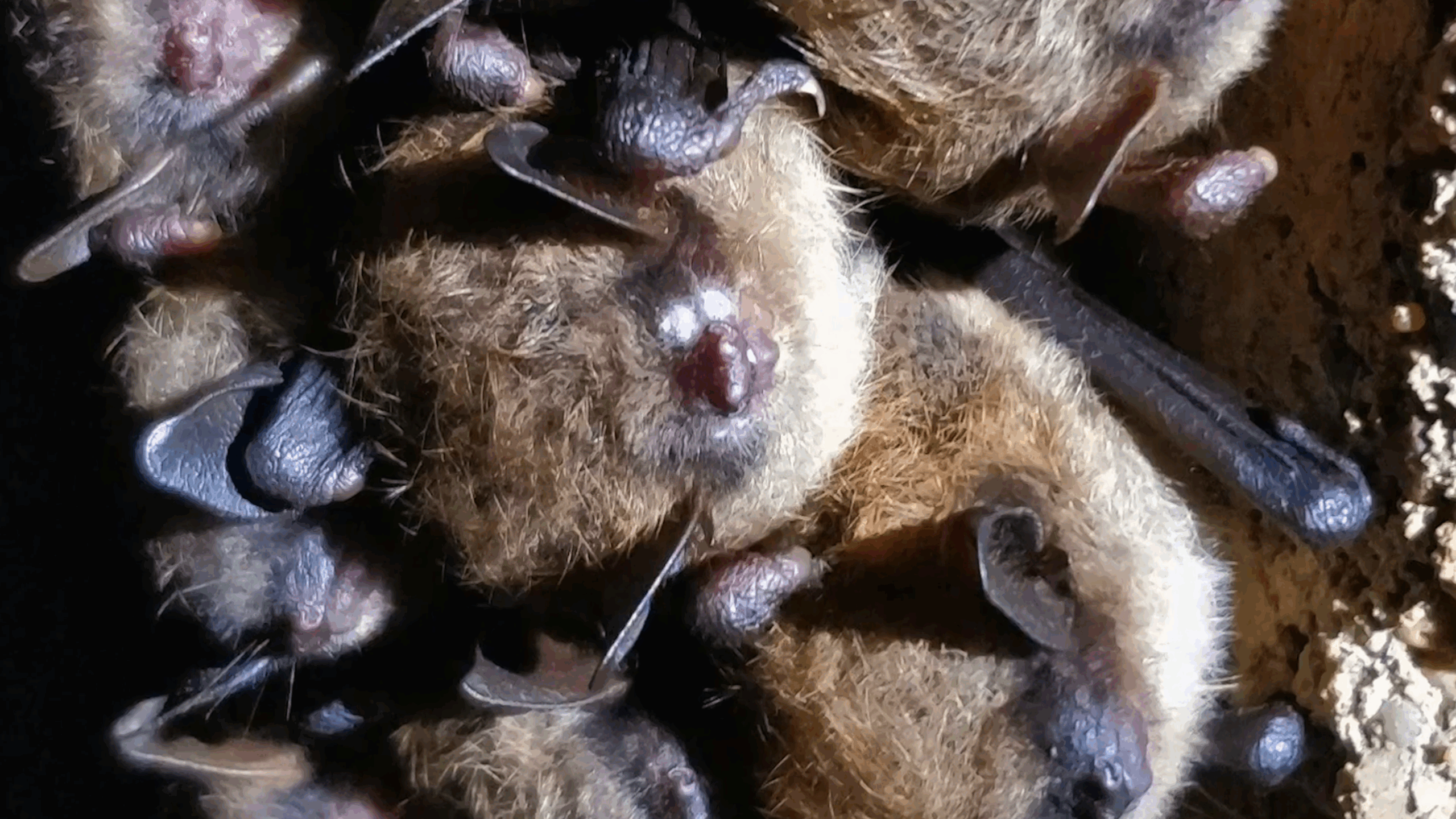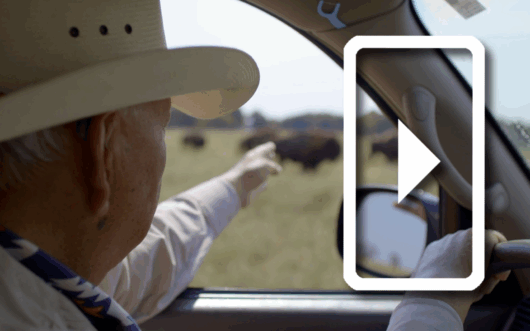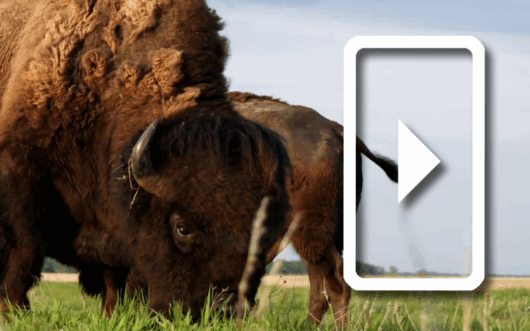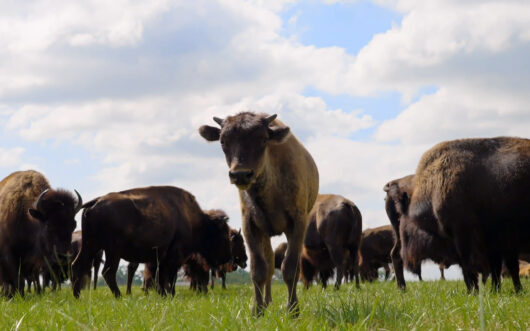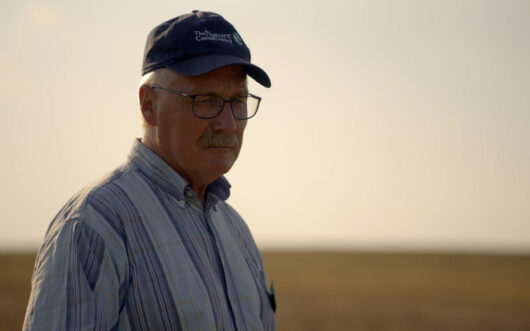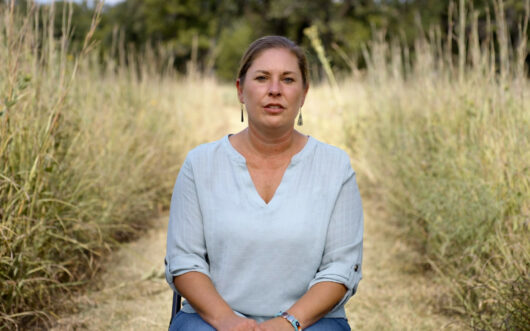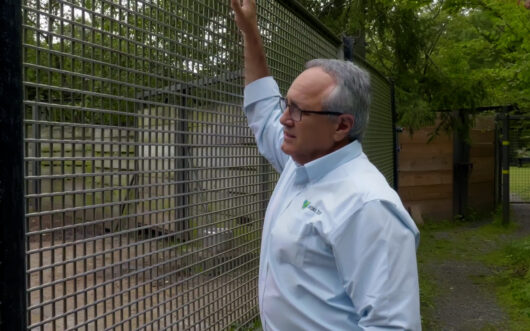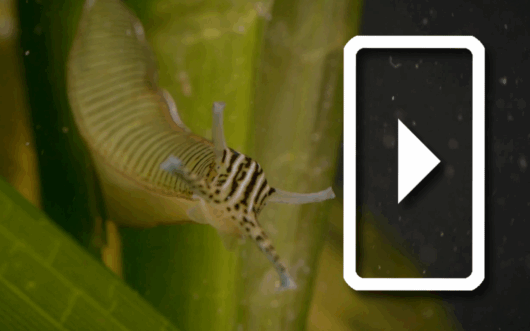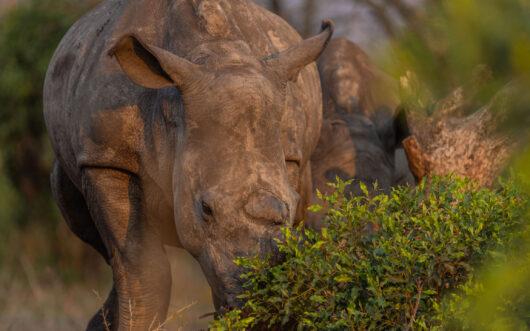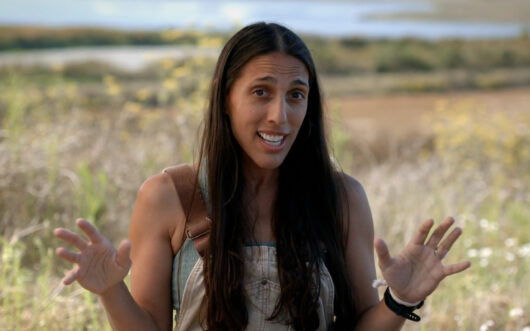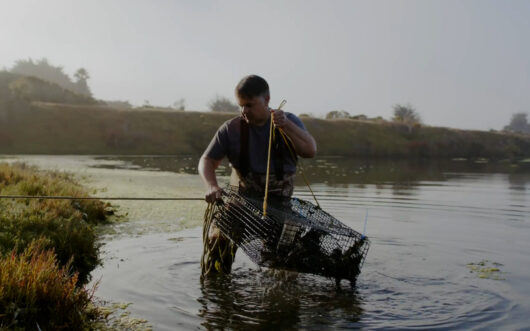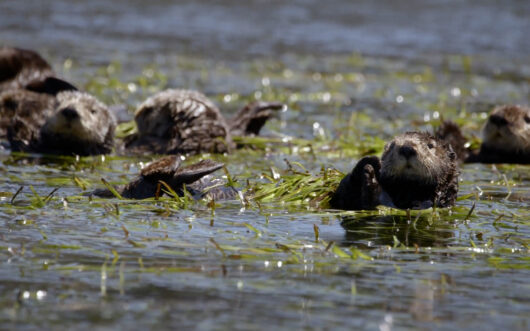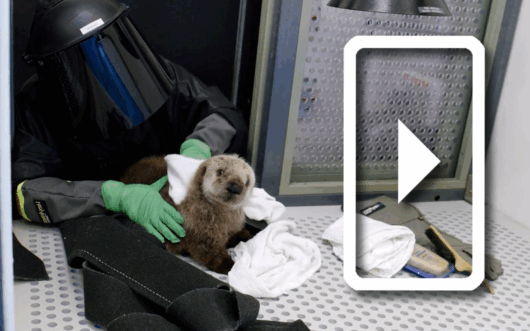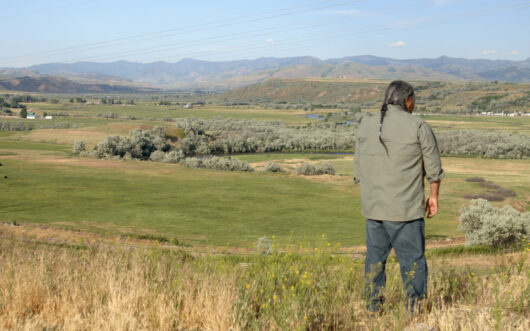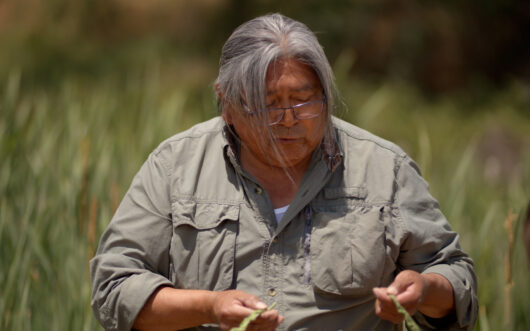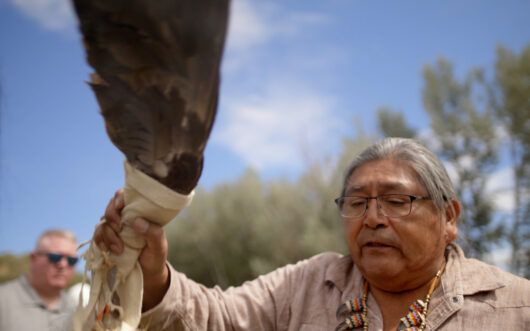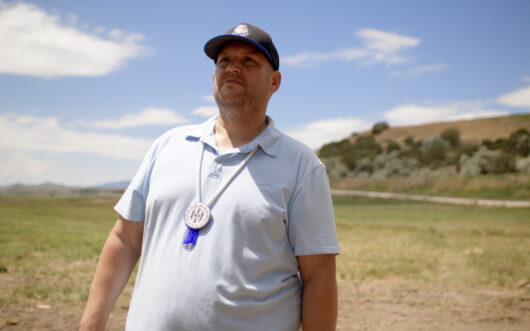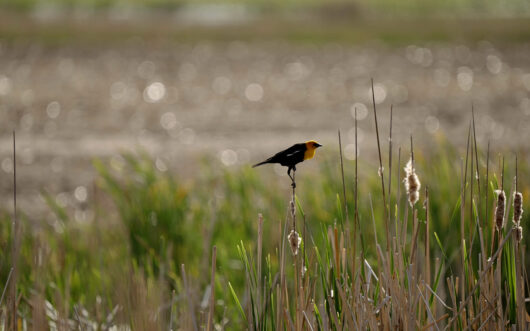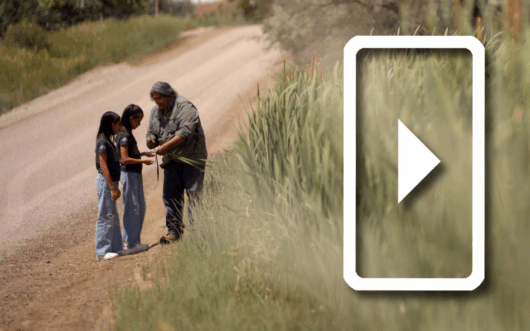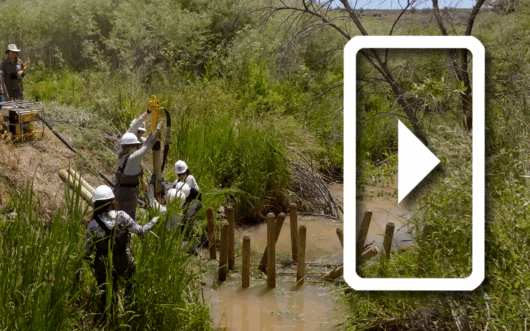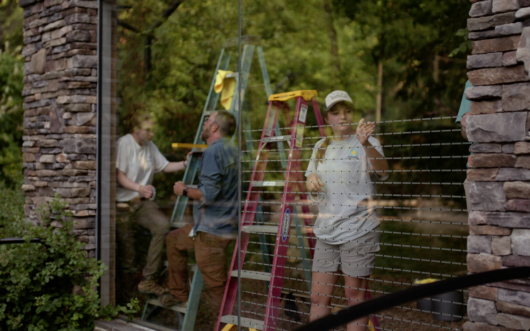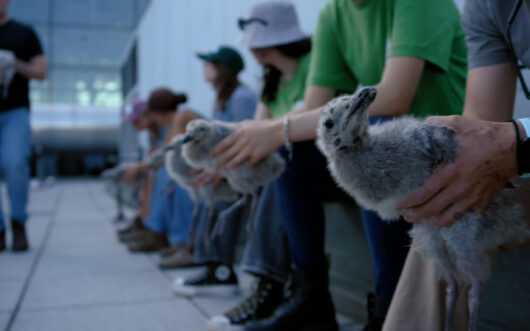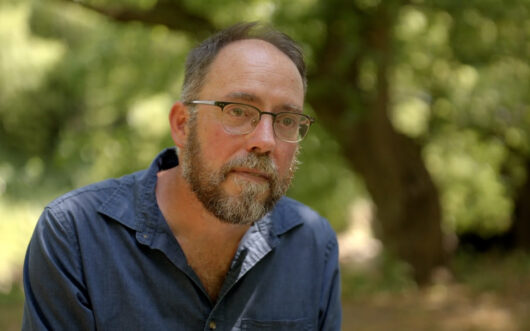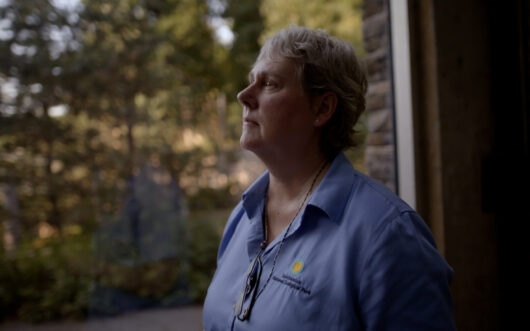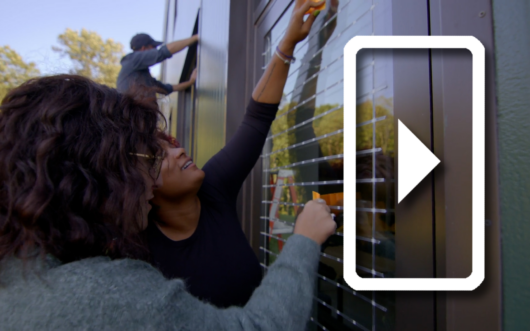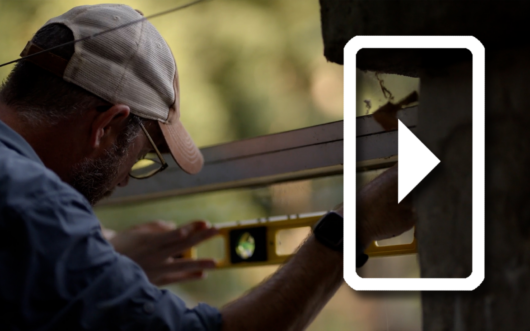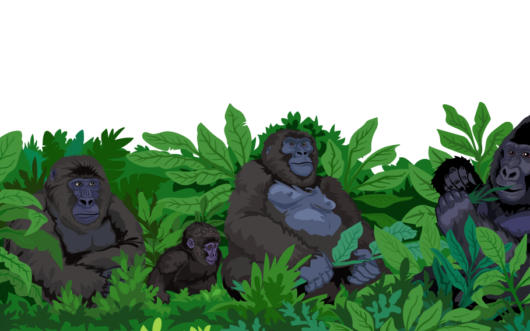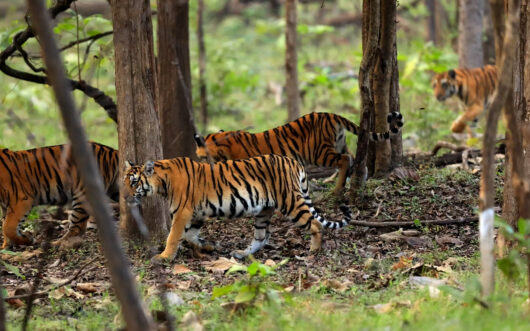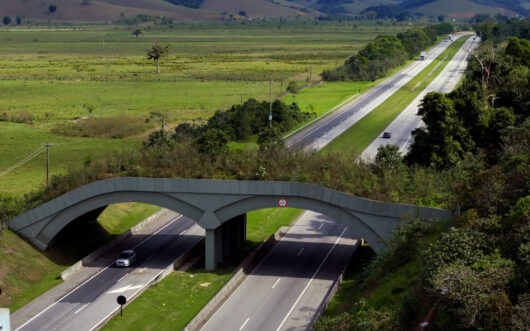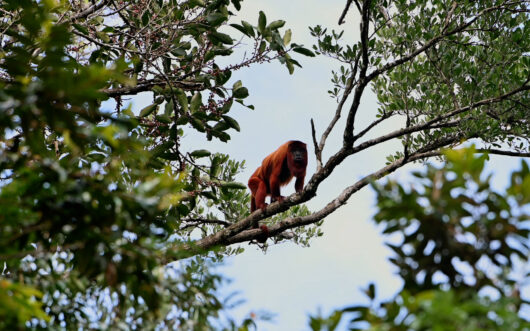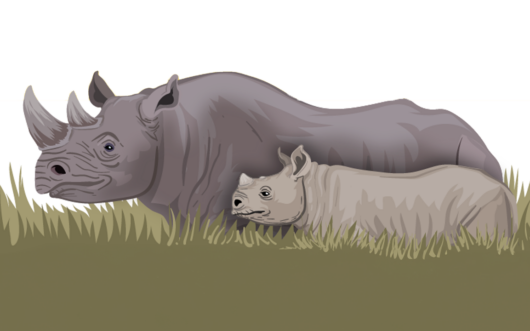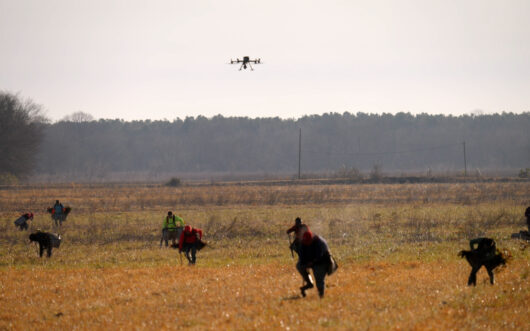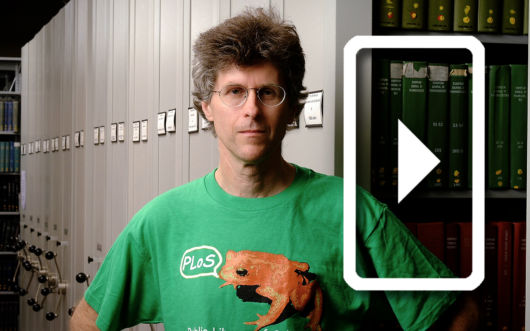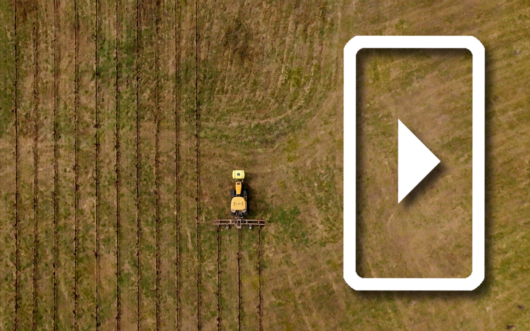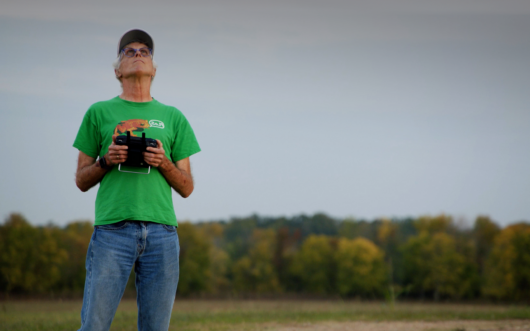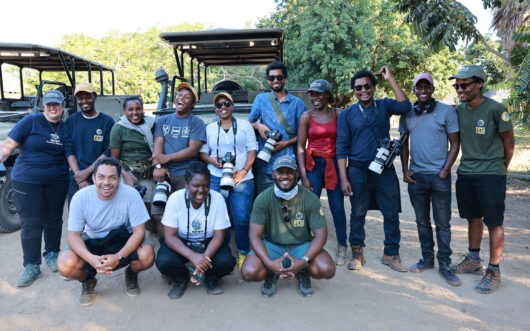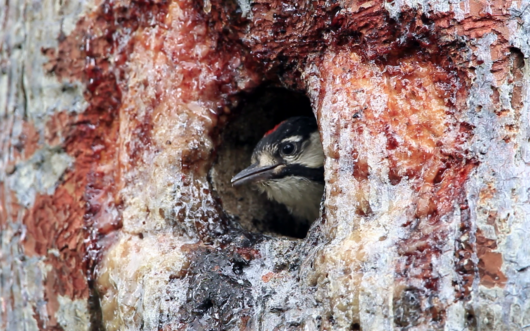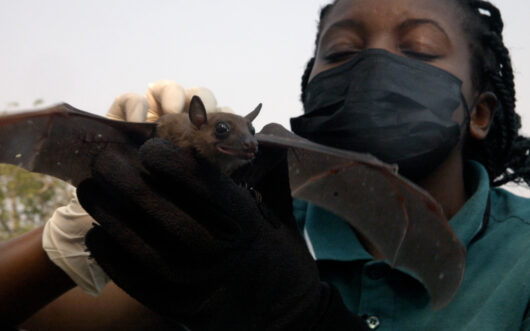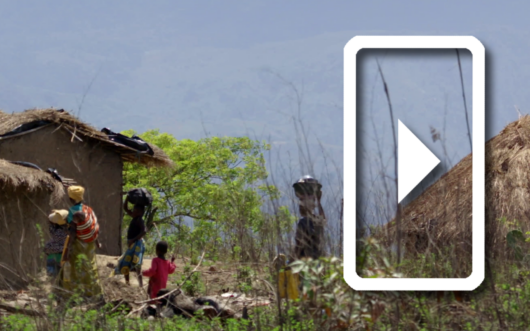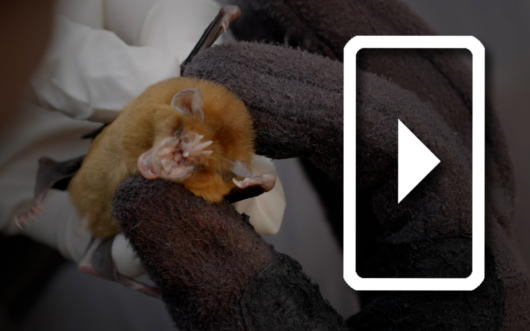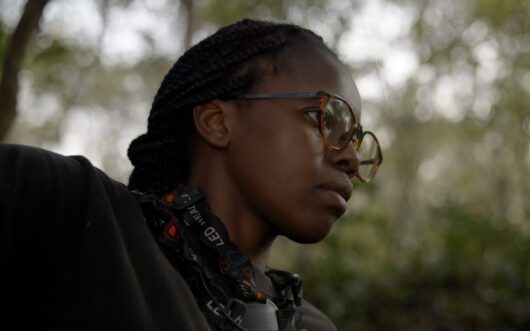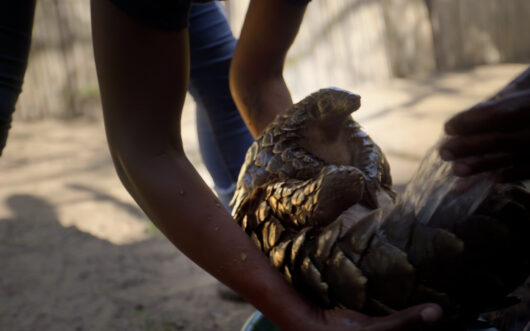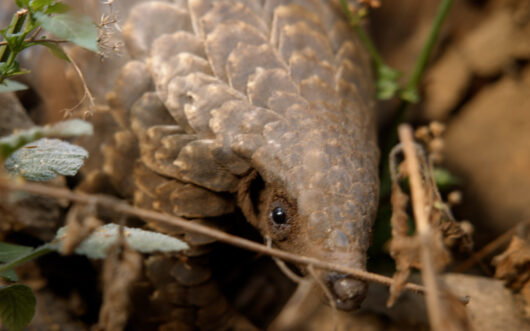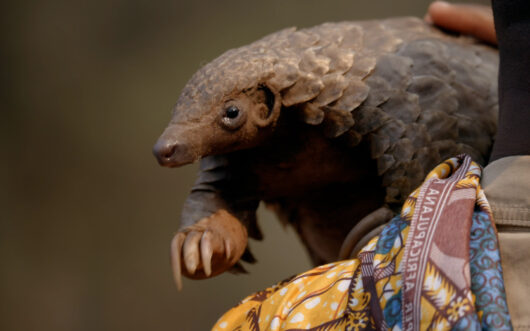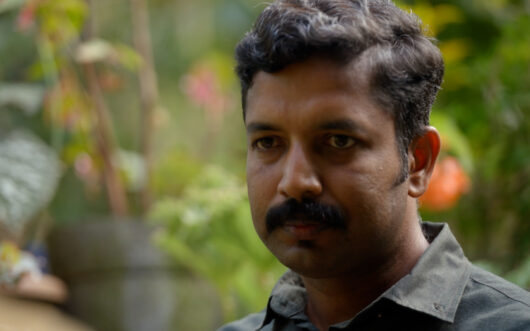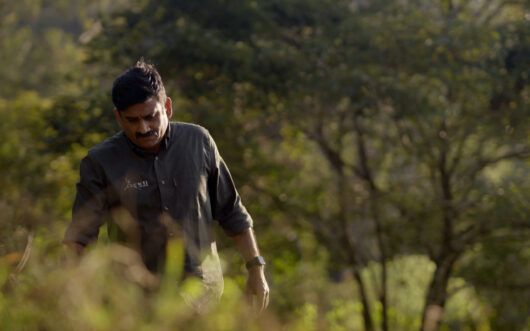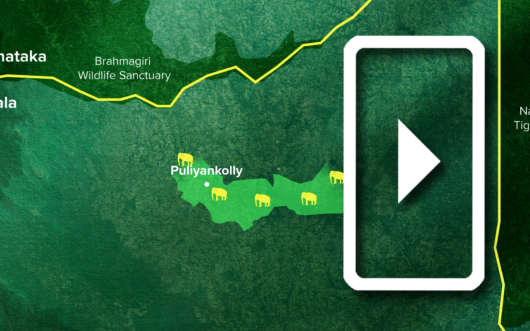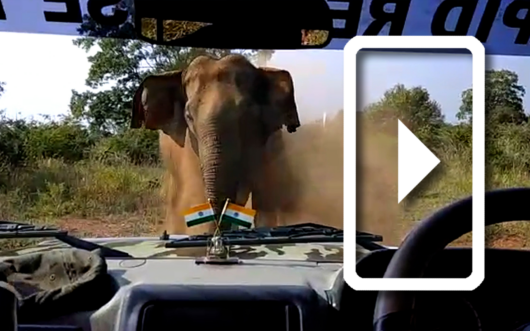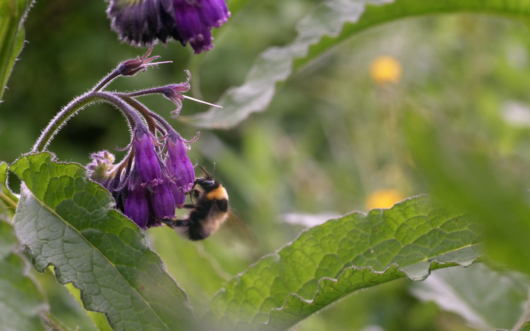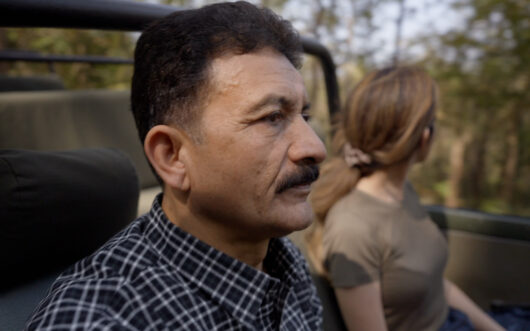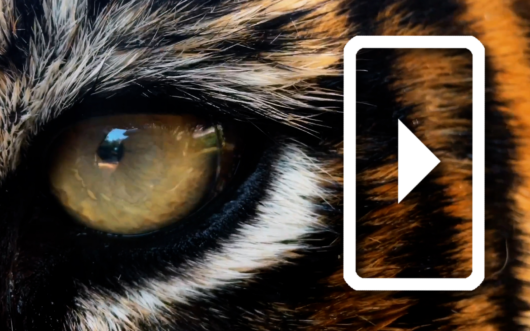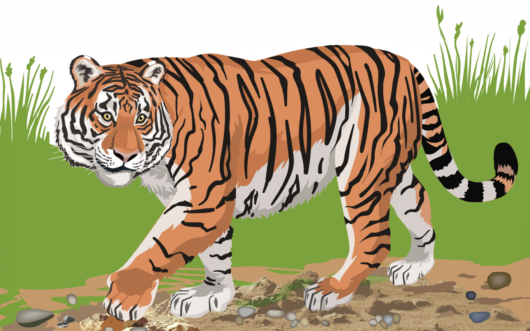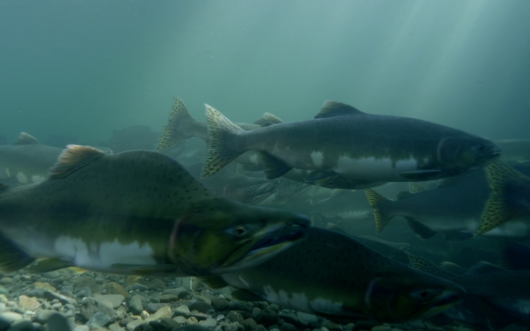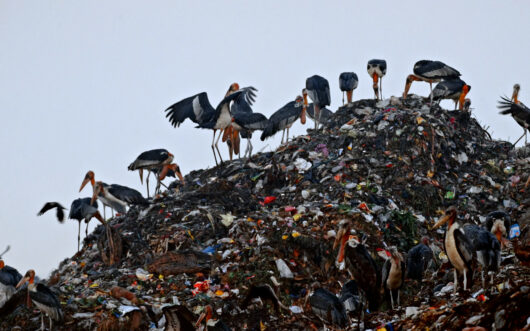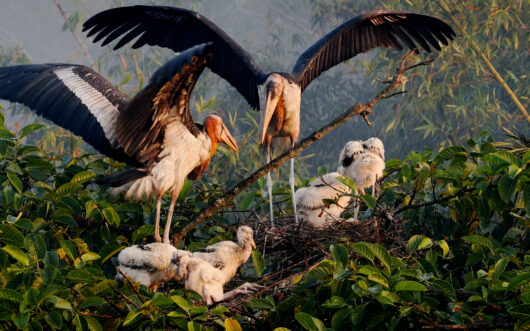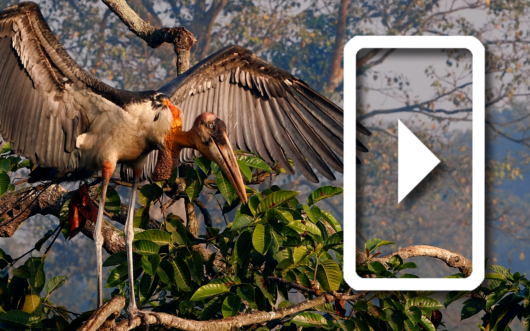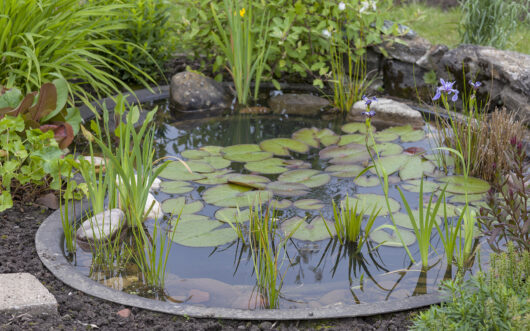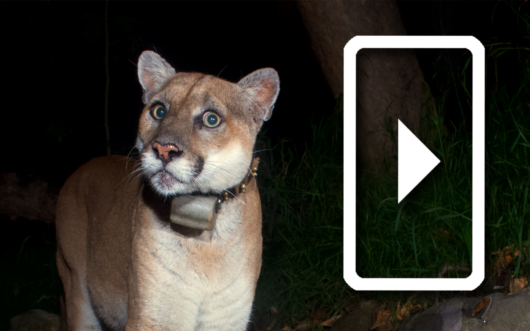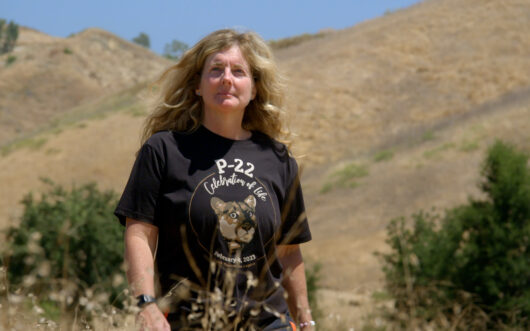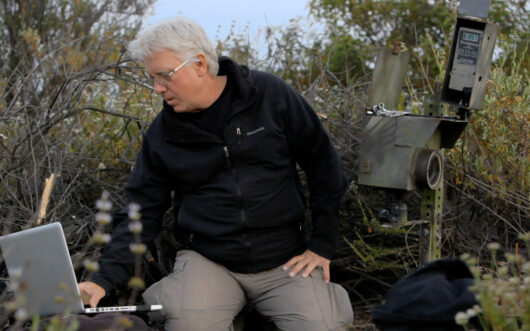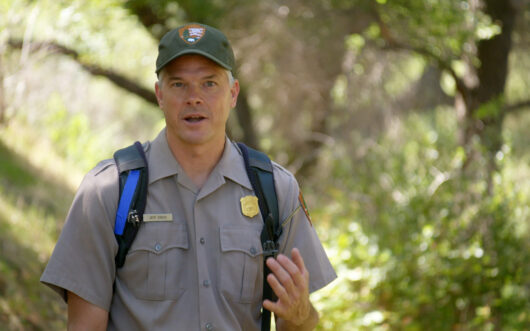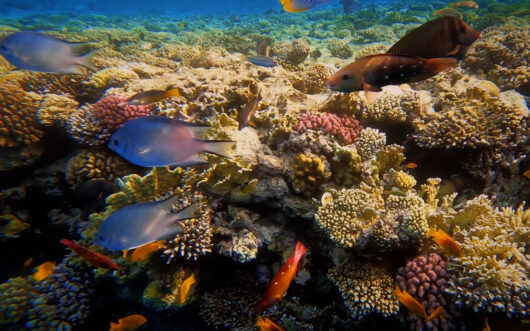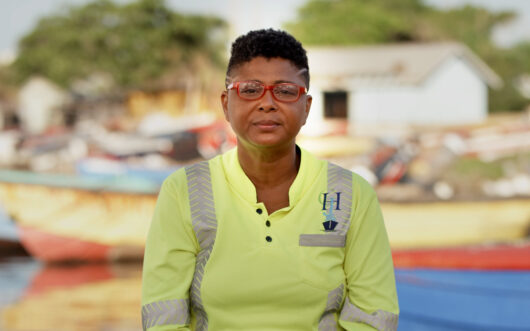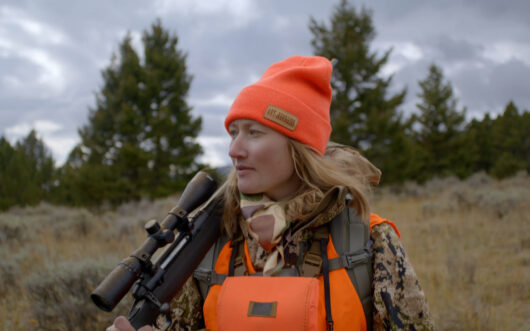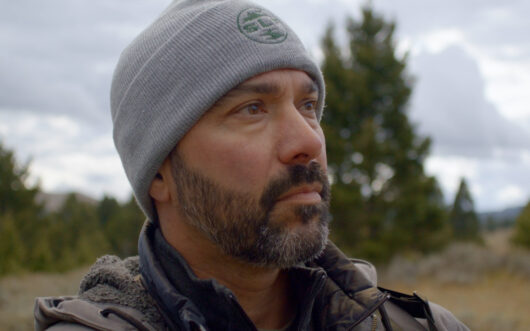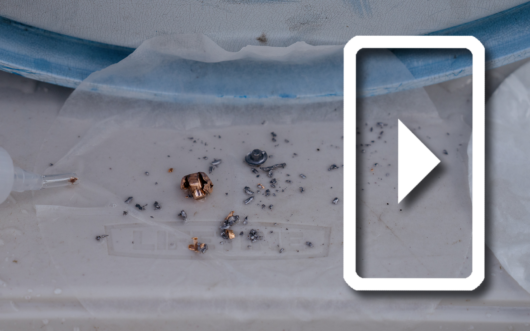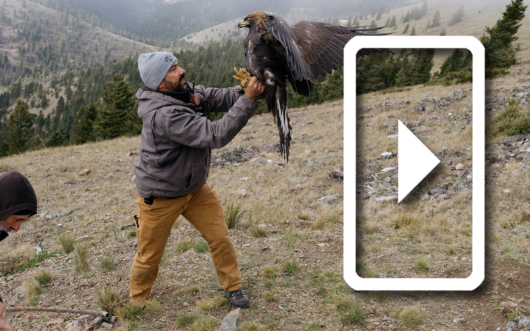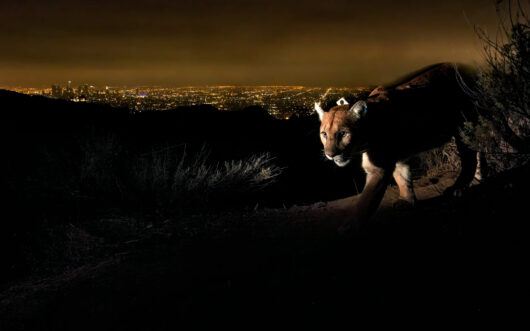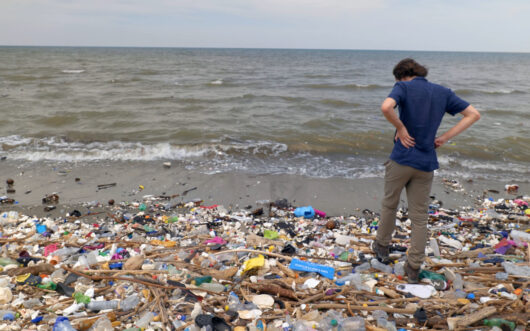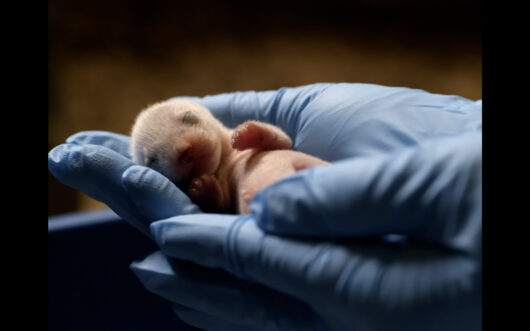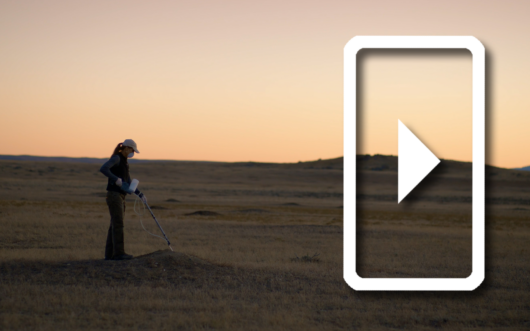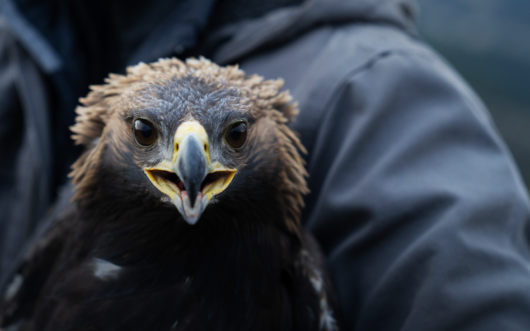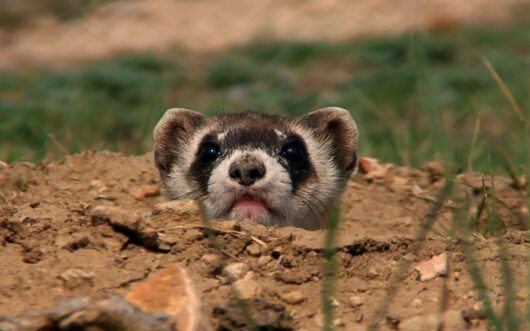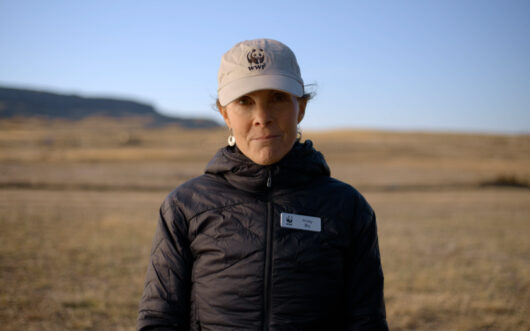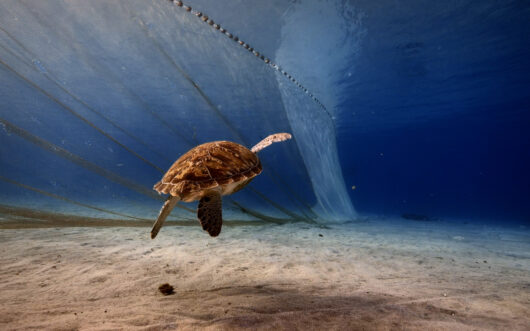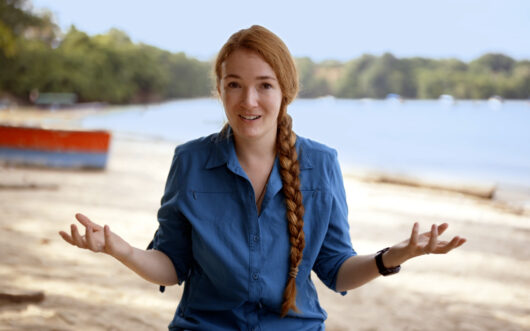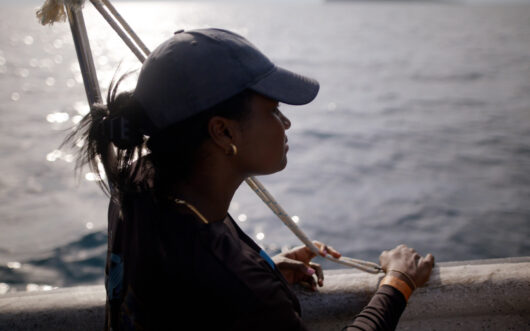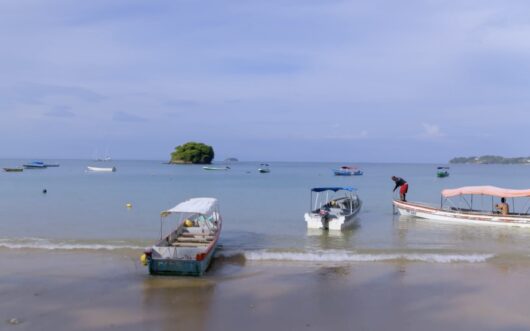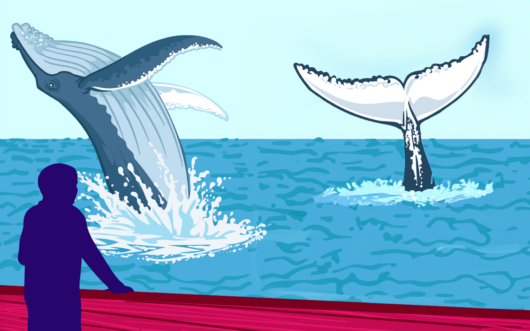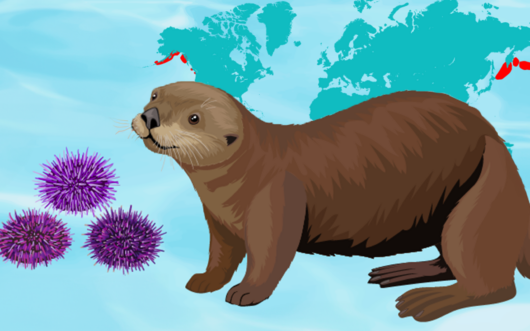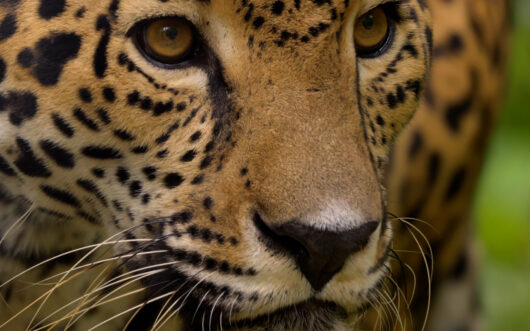Our relationship with gray wolves is a complicated one, spanning centuries of tension and hostility. In North America, wolves were vilified by European settlers beginning in the 1600s due to the perceived threat that the canines posed to livestock. As a result, wolves became the target of extensive hunting and bounty programs. It wasn’t until 1967 that the species was officially listed as endangered in the U.S. and broadly recognized as an asset to healthy, balanced ecosystems. In the 1990s, wolf populations were reintroduced to wild areas including Yellowstone National Park. Their recovery has been slow, but today there are about 6,000 gray wolves in the lower 48 states — and their numbers are increasing in many parts of their range.
Explore more stories from the full Conservation Comeback series now.
Insect-eating bats play an important role in their ecosystems, but their populations are in trouble. Here are a few ways to create bat habitat in your backyard.
Explore how conservationists in Brazil are reintroducing keystone species like agoutis, tortoises, and howler monkeys to restore seed dispersal and rainforest regeneration in Rio de Janeiro’s Tijuca National Park. This educator guide supports classroom discussion, NGSS-aligned learning, and hands-on opportunities for student engagement.
Explore how scientists in Brazil are working to save the golden lion tamarin from extinction by restoring forests, managing wild populations, and even developing vaccines to protect against deadly diseases. This educator guide supports classroom discussion, NGSS-aligned learning, and hands-on opportunities for student engagement.
Explore how conservation biologists are working to restore the longleaf pine forests of the southeastern United States and protect two keystone reptiles—the Eastern indigo snake and the gopher tortoise. This educator guide supports classroom discussion, NGSS-aligned learning, and hands-on opportunities for student engagement.
Explore how conservation biologists in Hawai‘i are racing to save the last honeycreepers from extinction by restoring habitats and tackling avian malaria through innovative mosquito control. This educator guide supports classroom discussion, NGSS-aligned learning, and hands-on opportunities for student engagement.
In Return of the Manatees, a community-led effort restores vital eelgrass habitat and creates a safe haven for Florida manatees. This educator guide supports classroom discussion, NGSS-aligned learning, and hands-on opportunities for student engagement.
In A Farm Goes Wild, farmer-turned-conservationist Derek Gow leads efforts to reintroduce beavers, water voles, and storks to the landscapes of Great Britain. This educator guide supports classroom discussion, NGSS-aligned learning, and hands-on opportunities for student engagement.
In Turtle Trackers, conservationists and researchers in southeast Florida work to protect nesting sea turtles and uncover the mysteries of leatherbacks’ decades at sea. This educator guide supports classroom discussion, NGSS-aligned learning, and hands-on opportunities for student engagement.
Explore how the scientists from the Maui Nui Seabird Recovery Project are working to save populations of declining shearwater seabirds. This educator guide supports classroom discussion, NGSS-aligned learning, and hands-on opportunities for student engagement.
Explore how cultural leadership, scientific collaboration, and ecological resilience can revive an entire watershed and strengthen the connection between people and place. This educator guide supports classroom discussion, NGSS-aligned learning, and hands-on opportunities for student engagement.
Explore how conservationists, landowners, and scientists are working to reintroduce beavers to Great Britain and restore the wetlands and waterways they once shaped. This educator guide supports classroom discussion, NGSS-aligned learning, and hands-on opportunities for student engagement.
Explore how collaboration among unlikely partners can protect a keystone species, revitalize critical habitat, and demonstrate that conservation success is possible when science and community work hand in hand. This educator guide supports classroom discussion, NGSS-aligned learning, and hands-on opportunities for student engagement.
Explore how conservation teams in Australia are training dogs to protect wildlife by locating invasive foxes and tracking endangered koalas. This educator guide supports classroom discussion, NGSS-aligned learning, and hands-on opportunities for student engagement.
Explore how New Yorkers are working to restore wild oysters and revive New York Harbor's ecosystem, and how these efforts protect both people and wildlife.
Explore how scientists, farmers, fishers, and even Dominican nuns are working to save Mexico’s endangered salamanders—the axolotl and the achoque—by restoring habitats and engaging local communities. This educator guide supports classroom discussion, NGSS-aligned learning, and hands-on opportunities for student engagement.
Before bats can be saved, they have to be studied. Across Wyoming, a dedicated team of scientists and wildlife experts spend long nights catching and tagging wild bats.
A deadly fungus is wiping out bat populations across North America, but a team of scientists may have found a game-changing solution.
Scientists work against the clock to test a groundbreaking vaccine that could save some of North America’s bats from the brink of extinction.
Dr. Michelle Verant is a wildlife veterinarian for the National Park Service who enhances and protects wildlife health and well-being in parks through technical assistance and training, policy and veterinary consultation, and science communication using approaches that recognize the interconnectedness of animals, humans, and the environment. Michelle completed her Doctor of Veterinary Medicine and Master […]
Dr. Tonie Rocke is a research scientist working on a vaccine for a fungal bat disease called white-nose syndrome.
White-nose syndrome (WNS) is a deadly fungal disease that has killed millions of bats across North America since it was introduced in the early 2000s.
The Osage nation has a cultural connection to bison going back countless generations, but their connection to the bison was severed by the species' near-extermination in the 1800s.
Bison are a keystone species that shape the prairie ecosystem through their grazing and wallowing. That’s why Bob Hamilton, a researcher with The Nature Conservancy, calls them the “kings of the prairie.”
First Nation tribes and conservationists join forces to rescue the species from extinction and return these mighty giants to their home on the prairie.
Bob Hamilton is the Director of the Tallgrass Initiative for The Nature Conservancy in Oklahoma.
Jann Hayman is the secretary of natural resources for the Osage Nation.
Pat Thomas was vice president and general curator for the WCS and the associate director of the Bronx Zoo.
Through a process called trophic cascade, the return of sea otters is restoring balance, keeping crab populations in check, and allowing vital seagrass meadows to thrive once again.
Dehorning rhinos — often seen as a drastic step in conservation — has effectively curbed poaching in South Africa, according to a new study.
Wildlife rehabilitation is the process of nursing sick, injured, and orphaned wildlife back to health so that they can be returned to the wild.
When removing a top predator from an ecosystem causes a domino effect down the entire food chain, it's called a trophic cascade.
Dr. Kathryn Beheshti is an assistant researcher at the University of California, Santa Barbara’s Marine Science Institute. Kat is a coastal marine ecologist that specializes in restoration ecology of salt marsh, seagrass, and kelp habitats.
Brent is a marine ecologist and conservation biologist with Sonoma State University. Research in his lab seeks to determine the processes that affect the stability of coastal ecosystems.
Sea otters are back, and their return is a breath of fresh air for the waters of Monterey Bay.
Orphaned sea otter pups face a harsh reality in the wild, but at the Monterey Bay Aquarium, a groundbreaking rehabilitation program is giving them a second chance.
The Northwestern Band of the Shoshone Nation has been landless ever since they suffered the worst massacre in U.S. history in 1863. Over 150 years later, the Tribe has purchased their ancestral homeland with a vision to return it back to nature.
Traditional ecological knowledge (TEK) refers to the body of knowledge, practices, and beliefs acquired by Indigenous people over hundreds or thousands of years through direct contact with their environment.
Rios Pacheco is Northwest Shoshone and Kewa Pueblo. He is a Tribal Elder in the Northwestern Band of the Shoshone Nation and serves as the Tribe’s Cultural Analyst and Advisor.
Brad Parry has served as the Vice Chairman for the Northwestern Band of the Shoshone Nation Tribal Council since 2017. He is employed by the Tribe as the Natural Resources Officer.
Passive acoustic monitoring — often simply called acoustic monitoring — is a tool used by ecologists and conservationists to study wildlife in their natural environment.
For the Shoshone people, Bear River has always been a lifeline — sustaining their culture, history, and way of life.
Building beaver dam analogs is restoring wetlands, slowing water flow, and creating the conditions needed for wildlife to return.
Smithsonian's National Zoo is on a mission to save birds from window collisions.
In the US alone, an estimated one billion birds die each year when they collide with windows. Now, two organizations help pave the way to a bird-friendly future.
Dr. Dustin Partridge is the Director of Conservation and Science at NYC Bird Alliance (formerly NYC Audubon), a nonprofit that protects wild birds and their habitats in New York City.
Brian Evans is a migratory bird ecologist at the Smithsonian’s National Zoo and Conservation Biology Institute, which studies and educates the public on the ecology of migratory birds.
Sara Hallager serves as curator of birds at the Smithsonian’s National Zoo and Conservation Biology Institute.
Making windows safe for birds at home is easy! Some treatments look like little dots, others use stretches of tape – and even temporary solutions like paint or soap make a difference!
The National Zoo in Washington DC had 10,000 square feet of glass that posed a threat to migrating birds – so experts at the Zoo began the massive effort to treat every pane of glass they could!
There are many ways to reduce bird-window collisions at home and in your community.
The mountain gorilla, a critically endangered subspecies of the eastern gorilla, has faced a dramatic decline over the past century. By the early 20th century, their population had dwindled due to habitat loss, poaching, and the spread of diseases from humans. At its lowest point in the 1980s, the mountain gorilla population was reduced to fewer than 250 individuals, with their survival hanging by a thread.
With its growing population and wealth of wildlife, India is at the forefront of creative, community-based solutions to human-wildlife conflict.
Using satellite trackers, scientists have discovered the whereabouts of young sea turtles during a key part of their lives.
For decades, conservationists have pushed for changes to U.S. 64, a busy two-lane highway to the popular Outer Banks that runs straight through the Alligator River National Wildlife Refuge — one of just two places in the world where red wolves run free. They may finally be getting their wish.
Brazil's Atlantic Forest is often shadowed by the vast Amazon, but it is just as biodiverse and at greater risk of vanishing without conservation action.
About 21.5 million acres of the Western United States are nationally protected, and thousands are being managed or co-managed by Native American tribes reclaiming ancestral relationships with native plants and animals. It’s no surprise, then, that Wild Hope hit a rich vein of conservation stories grounded in the West.
The smaller and rarer of the two African rhino species, the black rhinoceros has faced steep decline since the early 20th century.
The planetary impact of largescale animal agriculture on biodiversity is immense – from the release of greenhouse gases, to the demand for available land at the expense of native ecosystems. Studies show that 75% of all agricultural land on earth is committed to raising livestock, and replacing meat products with plant-based foods could free up […]
Innovative biochemist Pat Brown is the man behind the Impossible Burger. Now, he's set his sights on a rewilding project on a ranch in Arkansas.
Efforts to break our dependence on large-scale animal agriculture are real… and they're working on two fronts! First to create alternative options for protein that don't come from animals, and second, to transform defunct cattle ranches into revived forested ecosystems.
Scientist Pat Brown has made a name for himself in biochemistry, and more recently in the initiative to reduce humanity’s reliance on animal agriculture. Throughout his journey, he’s championed one particular philosophy: “Blast Ahead!”
Biology Pat Brown has influenced the fields of biochemistry, virology, and genomics throughout his career. Now, the renowned scientist sets his sights on the largest problem of all: climate change.
Bringing biodiversity back to a clearcut ranch in Arkansas is a daunting task, but the mission is clear: use trees and native plants as powerful tools for capturing and sequestering carbon.
It was a late-career epiphany that led “wacky genius” Pat Brown to abandon his academic career and commit himself to fighting global warming and biodiversity collapse. He did it, against all odds, by developing a surprising product: the revolutionary and delicious plant-based Impossible Burger.
Two Wild Hope episodes filmed in Gorongosa National Park and produced by NEWF African Science Film Fellows provide a model for empowering local film crews.
The red-cockaded woodpecker, a longleaf pine specialist that lives in the southeastern U.S., was one of the first species listed under the Endangered Species Act of 1973.
Economic growth and wildlife conservation often run in conflict, but Mozambican scientist Cesária Huo hopes to support a new sustainable and economically viable model for harvesting a potent natural resource: bat guano.
To successfully protect the wildlife in Gorongosa National Park, biologists like Cesária Huo know to first support the communities that call the park home.
Researchers survey the bats in Mozambique's Cheringoma caves looking for insectivorous species known to produce the best quality guano that can be harvested as fertilizer.
Cesaria Huo is a conservation biologist focusing on bat research in Gorongosa National Park.
From leaving the leaves to making a pumpkin bird feeder, here are a few suggestions from wildlife experts for a sustainable spooky season.
Pangolins are the only scaled mammal on earth, and unfortunately this unique and beautiful feature is the target of poachers and illegal animal traders seeking the scales for use in traditional medicine.
Pangolins are amazing, bizarre creatures that live in Central and Southern Africa. They feed exclusively and voraciously on ants and termites, and they’re perfectly specialized for this type of hunt.
Pangolins are the only scaled mammal on Earth. Unfortunately, this unique and beautiful feature is the target of poachers and illegal animal traders, who seek the scales for use in traditional medicine.
Shajan M.A. is a sociologist who has worked with Wildlife Trust of India (WTI) for the last 11 years. He joined as a Field Officer at the Elephant Corridor Securement Project in Wayanad, Kerala. He completed his post-graduate degree in social work from the University of Calicut, Kerala, and M.Phil. in psychiatric social work from […]
Jose Louise is the CEO of Wildlife Trust of India (WTI).
Protecting the migratory corridors for India's elephants benefits countless other plants and animal as well, making elephants an “umbrella species” whose protection benefits other wildlife that shares the same ecosystem.
In southern India, villages were built in the middle of an “elephant superhighway” used by the largest population of Asian elephants on Earth, leading to ongoing conflict that was dangerous for both the human residents and the elephants themselves.
Pawpaws are in season, ocean waves gain rights, and salmon can swim freely in the Klamath
In Madhya Pradesh, renowned as India’s “tiger state,” a team installs AI-integrated camera traps to reduce conflict and safeguard lives in a vital wildlife corridor home to 2 million people – and 300 wild tigers.
Piyush Yadav is a Conservation Technology Fellow at RESOLVE, where he focuses on developing and implementing new technologies for wildlife protection.
Dr. Himmat Singh Negi is a retired Indian Forest Service Officer who has spent more than three decades in the field of Tiger Conservation and related conflict mitigation.
Hrishita Negi is a Ph.D. candidate at Clemson University undertaking her research in the globally recognized tiger landscape of Central India.
AI-enabled cameras are being deployed in a part of India that has the highest concentration of tigers on Earth. These trail cams don’t just take a photo of whatever passes by, but analyze it to identify whether it’s a tiger.
Dr. Hrishita Negi grew up watching wild tigers. Her father, Himmat, worked in tiger conservation for decades, contributing to India’s success in doubling its tiger population over the past 50 years.
Tigers are one of the most iconic faces of wildlife conservation worldwide. These species are still endangered, but indeed on the rise — although it wasn't long ago that tiger populations teetered on the edge of extinction.
The Klamath River dam removal — the largest such project in U.S. history — is nearing completion. Soon, salmon will swim freely in the river and its tributaries for the first time in over a century.
In the northeastern part of India, the population of greater adjutant stork had declined to just 115 birds — until biologist Purnima Devi Barman launched a grassroots effort to do bring the species back from the brink.
When an animal feeds primarily on dead or decaying matter, it is known as a scavenger. Scavengers — like vultures, hyenas, and raccoons — often have bad reputations due to their association with garbage and death. But they are actually an essential part of a functioning ecosystem. Scavengers are nature’s cleanup crew, eating parts of […]
The IUCN Red List of Threatened Species, often referred to simply as “the Red List,” ranks how close some 163,000 plants, animals, and other species are to extinction. Using the latest research, scientists assign a status to each listed species, ranging from “Least Concern” to “Endangered” to “Extinct.” The Red List was established in 1964 […]
To help protect an endangered stork, biologist Purnima Devi Barman provided looms and training to local women to create textiles and clothes that feature the bird.
The greater adjutant stork is one of the largest — and rarest — storks on earth. But locals in one of their last strongholds in Assam, India considered them to be a bad omen until Purnima Devi Barman revitalized their public image.
Bumble bee brigades help citizen scientists contribute to pollinator conservation, the NWF has tips to help local wildlife beat the heat, and plastic bags are down 80% on UK beaches.
It took 15 long months of trial and error to photograph mountain lion P-22 walking in front of the famed Hollywood sign.
The Santa Monica mountains near Los Angeles are home to a wide range of wildlife—including coyotes and mountain lions—all cut off from the rest of the world by the city’s massive freeways.
A lifelong advocate for wildlife, Beth Pratt has worked in environmental leadership roles for over thirty years.
Steve Winter is a wildlife photojournalist with decades producing stories for National Geographic Magazine and other outlets. He specializes in wildlife, and particularly, big cats.
Jeff Sikich is a wildlife biologist for the National Park Service researching the impacts of urbanization and habitat fragmentation on mountain lions in Southern California.
Frog saunas could help fight chytrid, Iberian lynx are no longer endangered, and scientists in Hawaii are breeding heat-resistant corals.
Alecia has held many career positions, from software trainer to office administrator; however, outside of work she is heavily involved in volunteer associations focusing on education. Most recently, Alecia’s Clean Harbours Jamaica team has, in partnership with The Ocean Cleanup, removed over 1 million kg of garbage from the barriers and by extension from the […]
It’s estimated that up to 14 million tons of plastic end up in the world’s oceans every year—and 80% of it pours into the sea from polluted rivers. In Kingston, Jamaica, Alecia Beaufort and her team at Clean Harbors Jamaica have partnered with The Ocean Cleanup to stop the waste before it ever reaches the sea.
Hannah was born and raised under the Big Sky in Montana and has enjoyed outdoor pursuits her whole life. With a bachelor’s in marketing and a master’s in resource conservation, she has a unique perspective on outreach efforts for the benefit of conservation.
For over 15 years, Bryan has been a leading scientist documenting the link between lead-based ammunition and ingestion in wildlife. He co-founded and is Director of Sporting Lead-Free to promote an unbiased, non-political message within our community about the benefits of using lead-free sporting options to preserve both our hunting heritage and amazing Wyoming wildlife.
Conservationist and hunter Bryan Bedrosian started Sporting Lead Free to offer a solution to the problem of lead poisoning in eagles: advocating for the use of non-lead bullets as a permanent substitute for traditional lead ammunition.
Nearly half of all golden eagles and bald eagles in the U.S. have elevated lead levels in their bodies. This lead poisoning comes from the bullets used by hunters — not because the bullets harm the eagles directly, but the birds do scavenge on “gut piles” laden with lead fragments left behind after successful hunts.
After years spend researching local wildlife, like the iconic cougar P-22, biologists around Los Angeles pinpointed the vital location for a wildlife crossing to be built to restitch an entire ecosystem.
At the age of 18, Boyan Slat founded The Ocean Cleanup and set out to clean plastic from the Great Pacific Garbage Patch. Ten years later, the team is installing catchment systems at the mouths of rivers to stop plastic pollution of the seas at their source.
Black-footed ferrets are still alive today thanks to the combined efforts of scientists, zoos, tribes, and other partners across North America. The work hasn’t been easy — it’s involved a decades-long captive breeding effort, wild releases at 30 different grassland sites, and even the development of a vaccine to protect against plague! It’s been a […]
Black-footed ferrets nearly went extinct several times in the 20th century. Today, the current largest threat to their survival is a non-native disease called sylvatic plague.
When plowing, poisoning, and non-native plague wiped out nearly 95% of prairie dogs, the ecosystem collapsed around them. Today, conservationists control the disease by providing vaccine-laden treats called “Fip Bits” to help the prairie dogs — and those that depend on them — finally rebound!
Golden eagles are powerful enough to hunt prey as large as deer, but they’re falling victim to deadly lead poisoning introduced to the wild by another potent hunter: us.
Black-footed ferrets have come back from near extinction thanks to breeding, cloning and reintroduction programs that have brought them back to the western prairie. Now, these wild populations are threatened by a plague that targets the prairie dogs they depend on for food — and even the ferrets themselves.
With over 25 years of experience in the wildlife field, Kristy Bly’s expertise is on the conservation and restoration of black-footed ferrets, black-tailed prairie dogs, and swift fox in the North American Great Plains.
Hope for Hawaiian honeycreepers, beavers in London, a snake's triumphant return, and rewilding on college campuses.
Fishing gear entanglement happens when fishing gear like nets and longlines gets caught around the limbs or body of an animal, causing serious injury or death.
Callie Veelenturf is a marine conservation biologist specializing in sea turtles, the founder of The Leatherback Project, and a National Geographic Explorer.
Aida Magaña Manzzo is a nautical engineer and community leader for the Saboga Wildlife Refuge. She has been recognized as a Hope Spot Champion for her marine conservation efforts in the Pearl Islands.
Marine biologist Callie Veenlenturf came to the Pearl Islands to study sea turtles, but soon helped spark passage of remarkable laws that grant legal rights to nature and the turtles themselves.
Humpback whales are truly a global species. These mammals have one of the longest migrations around, traveling up to 10,000 miles in a single year — and their beautiful, complex songs are heard by sailors and tourists in every corner of the globe.
Sea otters are a marine mammal beloved by many, but it wasn't long ago that they teetered on the brink of extinction. The international fur trade decimated sea otter populations starting in the 1700s, and by the early 1900s, their wild population fell to less than 1% of their original numbers.
More than 35% of land in Belize is protected, and that’s been good for jaguars that live in these refuges — but for populations to thrive, the cats need to move from one safe area in the north to another in the south across a landscape of farms and towns.
